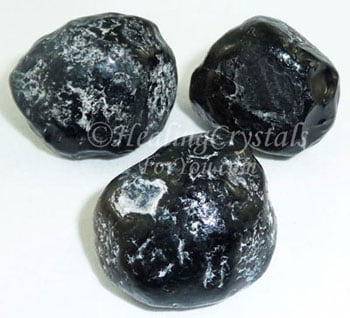Apache Tear Meaning
This variety is a stone of truths that can reveal secrets and answer your questions. Apache Tears Meaning Apache Tears have strong ties to the Earth Mother, which is why many metaphysical practitioners use them for grounding or improving their connections with the natural world. Because of this maternal nature of Gaia’s energy, generally Apache Tears have strong symbolic connections to protective actions.
'Apache tears' is the popular term for rounded pebbles of obsidian or 'obsidianites' composed of black or dark-colored natural volcanic glass, usually of rhyolite composition and bearing conchoidal fracture. Also known by the lithologic term 'marekanite', this variety of obsidian occurs as subrounded to subangular bodies up to about 2 inches in diameter, often bearing indented surfaces.[1] Internally the pebbles sometimes contain fine bands or microlites and though in reflected light they appear black and opaque, they may be translucent in transmitted light. Apache tears fall between 5 and 5.5 in hardness on the Mohs scale.[2]
Geology[edit]
Apache tears originate from siliceous lava flows, lava domes or ash-flow tuffs, often in close association with or embedded in, gray perlite. The spherules occur as cores within perlite masses that typically exhibit texture of concentrically curved, onion-skin fractures. Formation is apparently related to differential cooling and various alkali and water contents. Excessive water present during cooling and quenching of rhyolitic lava causes obsidian to hydrate (i.e., water entering the obsidian glass converts it to perlite). Where perlite is incompletely hydrated, fresh obsidian cores remain as pebbles of marekanite, or Apache tears; this origin has been occasionally described in the geologic literature (for example,[3]).
Apache tears are well known from tertiary volcanic terrain in numerous localities throughout the western United States, particularly Arizona, from where specimens were widely collected and sold in the lapidary and specimen trade.[4] Several districts in western Nevada also have yielded abundant Apache tears eroding from tuff beds; such areas have been popularized in the lapidary trade through guides for rockhounds.[5] Specimens from many of these sites have been avidly collected by rockhounds and lapidary enthusiasts, are often tumbled and may be considered semi-precious gemstones; locations are noted in the section 'Gemstones of Nevada' by Rose and Ferdock.[6]
Culture[edit]
The name 'Apache tear' comes from a legend of the Apache tribe: about 75 Apaches and the US Cavalry fought on a mountain overlooking what is now Superior, Arizona, in the 1870s. Facing defeat, the outnumbered Apache warriors rode their horses off the mountain to their deaths rather than be killed. The wives and families of the warriors cried when they heard of the tragedy; their tears turned into stone upon hitting the ground.[7][8]
American singer songwriter Johnny Cash wrote a song entitled 'Apache Tears' for his 1964 album Bitter Tears: Ballads of the American Indian.
See also[edit]
References[edit]
- ^American Geological Institute, Gary, Margaret, McAfee, Robert, Jr., Wolf, Carol L., eds., 1972, Glossary of geology: Washington, D.C
- ^Apache Tears Obsidian Education and InformationArchived June 3, 2012, at the Wayback Machine
- ^Mrazova, Stepanka & Gadas, Petr, 2011, Obsidian balls (marekanite) from Cerro Tijerina, central Nicaragua: petrographic investigations: Jour. Geosci., v. 56, p. 43-49
- ^Sinkankas, John, 1959, Gemstones of North America: Van Nostrand; p. 503-508
- ^Kappele, William A., 1998, Rockhounding Nevada: A guide to the state’s best rockhounding sites: Falcon Press
- ^Castor, Stephen B. & Ferdock, Gregory C., 2004, Minerals of Nevada: Univ. of Nevada Press, NV Bur. Mines & Geol. Special Publication 31, p. 83
- ^'Archived copy'(PDF). Archived from the original(PDF) on 2014-02-09. Retrieved 2015-05-23.CS1 maint: discouraged parameter (link) CS1 maint: archived copy as title (link)
- ^Native American Legends


Other Names
Black Obsidian
Associations
Deity: Saturn, Cronos
Sabbat: Mabon
Planet: Saturn, Pluto
Element: Fire
Zodiac: Capricorn, Sagittarius, Scorpio
Chakra: Root
Other Gems: Obsidian, Snowflake Obsidian
Description

Apache Tears appear as small, smooth stones. They may appear to be an opaque black, but when held to the light they reveal their smokey black, red or brown translucency. They have a Mohs rating of 5 to 5.5, meaning they are average in hardness – neither very hard nor very soft.
About
Apache Tears are formed inside perlite, a volcanic glass which is made when water enters an obsidian lava flow as it cools. If the water does not permeate the core, this remains as a nodule of obsidian which we call Apache Tears.

Health
Apache Tears can be used as an aid against depression, and to lift the spirits in general. They enhance the immune system, and detoxify and fortify the body. Apache Tears can be used to calm muscle spasms. They are also beneficial for the absorption of vitamins, and can help with ailments of the stomach and intenstines.
Magic
Apache Tears can help you ground yourself, and develop a connection with the earth. They can give you courage and strength and they bring hope in difficult times. Apache Tears can also help you deal with forgiveness – giving to others and accepting it yourself.
Apache Tears are also good cleansing stone, dispelling negativity in the environment and helping to eliminate it from your emotions as well. They can also provide good protection from negative energies, including psychic attacks.
Legend & Lore
This stone draws its name from a tale about Apache Indians surrounded and out-numbered by the military in Arizona. All the Apaches were either killed by gunfire, or chose to leap from the cliff edge instead. The Apache women stood at the foot of the cliff and wept for their dead, and so great was their grief that the Great Father took their tears and embedded them in black stones. These stones, when held to the light, reveal the transluscent tears of the Apache. It was said that anyone carrying one of these stones would never need to cry again, for the Apache women have shed enough tears in their place.
Apache Tear Stone Jewelry
Related
